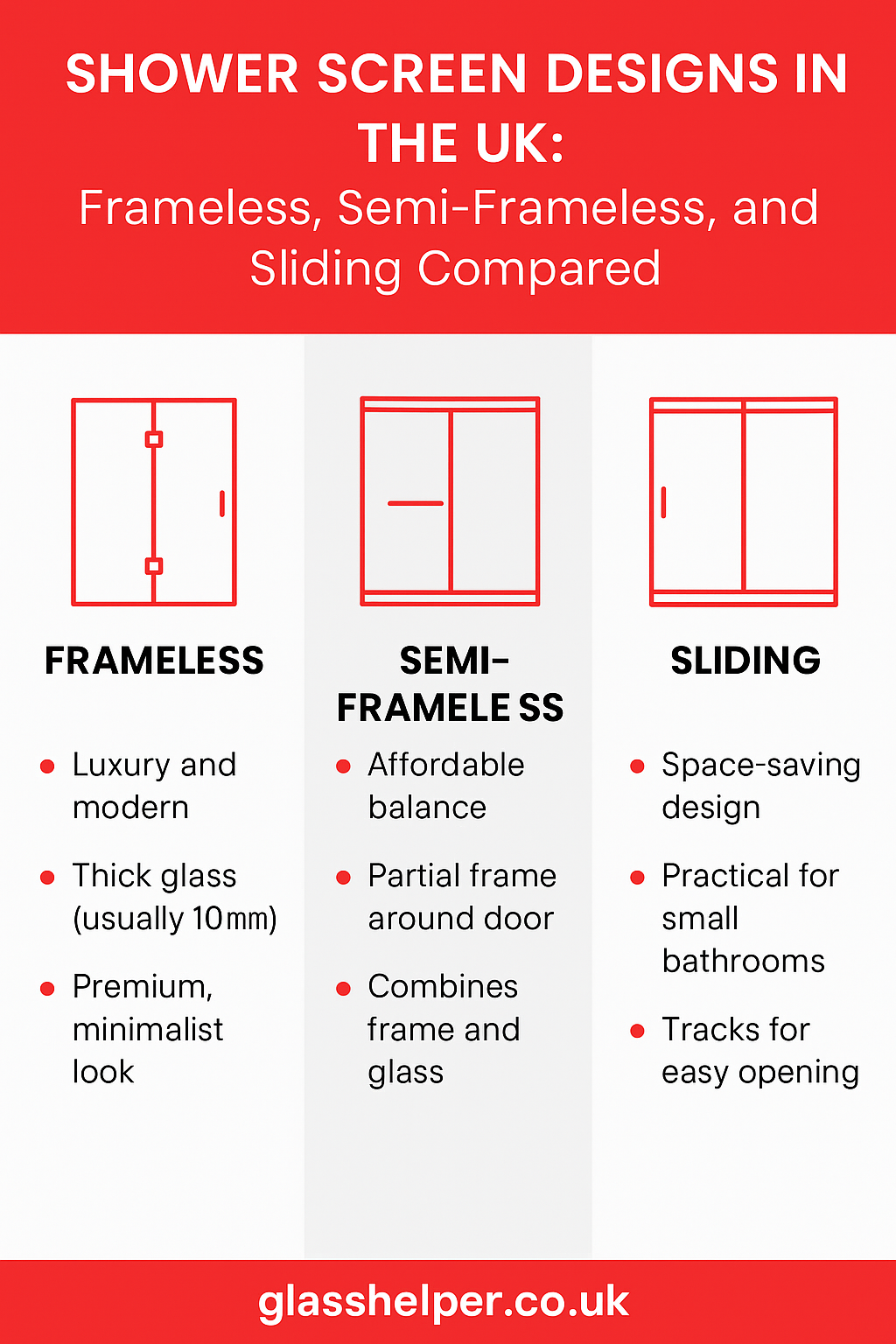Shower Screen Designs in the UK Frameless, Semi-Frameless, and Sliding Compared
Design Guide · 2025
Read time: ~7 mins · Updated: 22 Sep 2025
Choosing the right shower screen design can transform both the look and function of your bathroom.
In the UK, the three main styles—frameless, semi-frameless, and sliding—each bring unique advantages and trade-offs.
This guide compares them to help you pick what’s best for your space, budget, and aesthetic, while staying compliant with Glass & Glazing Federation guidelines and FENSA regulations.

Frameless
Frameless shower screens are minimalist and modern. They don’t have any metal frame around the edges of the glass, giving a seamless, clean look. Key features include:
- Usually 10mm toughened glass or thicker — strong enough to stay rigid without a frame.
- Minimal hardware (hinges, clips) to support the glass; often high quality stainless steel or chrome finishes.
- Wide open feel — ideal for walk-in showers or bathrooms with glass as a design feature.
- More expensive, heavier glass, and requires careful installation for drainage and sealing.
Semi-Frameless
Semi-frameless screens are a compromise between frameless and framed designs. They include small frame parts (typically around glass edges) and can offer good value and flexibility. Highlights:
- Glass usually 6-8mm thick; small frame parts offer extra support without the full cost of a full frame.
- Good for standard bathroom layouts, offering a more premium appearance without the full expense of frameless screens.
- Hardware and profile frames (for example, along the top or edges) help support and reduce flex or movement.
- Lower cost and easier to install than frameless, but slightly less aesthetic purity and more frequent cleaning of frame edges.
Sliding
Sliding shower screens are excellent for maximizing space, especially in smaller bathrooms where swinging doors aren’t practical. Key points:
- Glass panels slide on tracks (top and/or bottom), sometimes semi-framed for added stability.
- Thickness typically 6-10mm depending on design; thicker glass needed for larger panels.
- Great for compact bathrooms since sliding doors don’t require clearance to swing open.
- Requires track maintenance and periodic cleaning to ensure smooth operation.
Head-to-Head Comparison
Style & Aesthetic
- Frameless: sleek, minimal, luxury look
- Semi-Frameless: modern with subtle framing
- Sliding: practical, depends on visible tracks
Cost & Installation
- Frameless: highest cost, precise fit, premium hardware
- Semi-Frameless: moderate cost, straightforward install
- Sliding: mid-range, cost varies by track/hardware
Maintenance & Durability
- Frameless: minimal cleaning, fewer crevices
- Semi-Frameless: frames collect soap, need upkeep
- Sliding: tracks require regular cleaning & lubrication
Thinking of upgrading your shower screen?
Explore Shower Screens at GlassHelp
Frequently asked questions
Is frameless always better?
Not necessarily—it looks sleek but needs thicker tempered glass, premium hardware, and careful sealing. Budget and space should guide your choice.
What thickness do semi-frameless screens usually use?
Typically 6-8mm safety glass. Reinforced options may allow larger panels.
Are sliding shower doors safe?
Yes—if the glass is BS EN safety certified and hardware is properly installed. They’re ideal for small spaces.
Which design offers the best balance of cost and style?
Semi-frameless often provides the sweet spot—modern look with reasonable cost and simpler installation.
